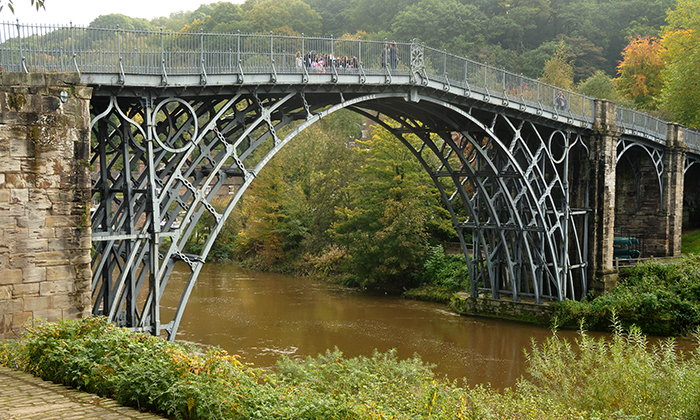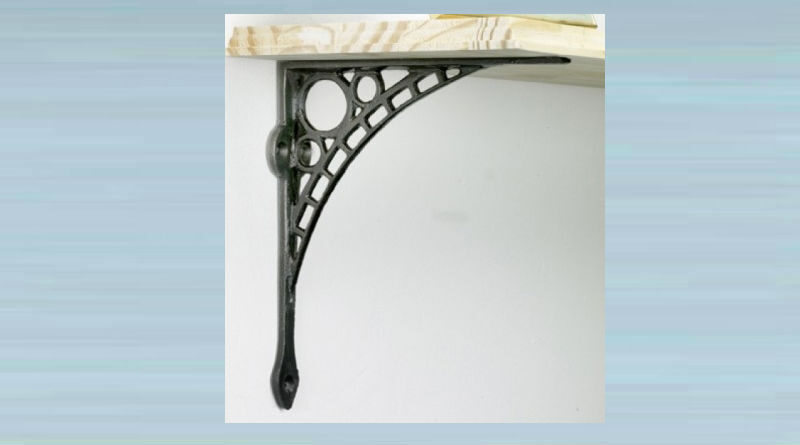26. Iron Bridge Shelf Bracket
Updated on 19 February 2021
The Iron Bridge Shelf Bracket is inspired by the iconic Iron Bridge, built by a Quaker family.
The Quaker family were the Darbys in Shropshire, England, and the Iron Bridge opened in 1781 as the world’s first iron-made bridge.
The Darbys And The Industrial Revolution
The Darbys and their influence over the Industrial Revolution began nearly 75 years before the Iron Bridge was built.
In 1708, Abraham Darby I (1678 – 1717) came to Shropshire to repair an iron-making furnace at Coalbrookdale. Darby I had begun his career as a brass maker and upon repairing the furnace at Coalbrookdale he discovered that iron could be smelted with coke instead of charcoal.
Using coke in the smelting process was superior to charcoal because coke, a manufactured form of coal, was in plentiful supply. Smelting iron with coke freed the iron industry from the need to rely on trees, which charcoal came from. Also coke had far less impurities than charcoal and became more cost effective. Darby I leased the ‘coke’ furnace he’d repaired and set up an accompanying foundry that was soon mass producing kettles, pots and cauldrons.
Abraham Darby I died in 1717 when his son Abraham Darby II (1711–1763) was only six. Until the son was old enough to take over the family business, the foundry was managed by Darby II’s mother, Mary, and some fellow Quakers who set up the Coalbrookdale company. Unfortunately, Mary died a year later but the newly established Coalbrookdale company ensured iron production continued uninterrupted.
Like his father, Darby II was an innovator and when he joined the company in 1732 he built a steam-powered engine that could recycle water. By recycling its water supply, the foundry became even more efficient and allowed the company to grow by taking over several nearby furnaces and upgrading them with the new technology.
Darby II would also influence the newly emerging railway industry. Until then, wooden carts on wooden rails pulled by horses had been used to transport iron and raw materials. Darby II used iron wheels and rails, which were far more durable and longer lasting than wood. The use of iron over wood would dominate railway building and by the time that the first commercial steam locomotives appeared in the early 19th century, iron had become the material of choice for construction.
Building The Bridge
By the time Abraham Darby III (1750 – 1789) joined the company in 1768, Coalbrookdale was a major employer that provided a school and cottages for its workers as well as paying a higher wage.
To keep up with increasing demands on supply, a bridge was needed to cross the River Severn. Shares were issued to raise the £3,200 needed to build the bridge with Darby III agreeing to pay for any overspend himself.
The bridge had been estimated to require 300 tons of iron , but ended up using 369. This created an overspend of around £3,000, nearly doubling the cost of the original estimate and leaving Darby III in debt for the rest of his life.

The iron bridge was opened in 1781 and by the mid-1790s the bridge was highly profitable, with its tolls giving shareholders an annual dividend of 8%.
Nearly 150 years later, in 1934 the bridge was designated a Scheduled Ancient Monument and closed to vehicular traffic. Tolls for pedestrians were collected until 1950. The bridge, the adjacent settlement of Ironbridge and the Ironbridge Gorge all now form the UNESCO Ironbridge Gorge World Heritage Site.
Coalbrookdale is Panel 33 (opens in a new window) of the Quaker Tapestry.
The Iron Bridge Shelf Bracket is available to buy from Black Country Metal Works (opens in new tab).
The 27th of the Quakers in 50 Objects is a Does My Bomb Look Big In This Hat
Images from jewelstours.co.uk and blackcountrymetalworks.co.uk/

